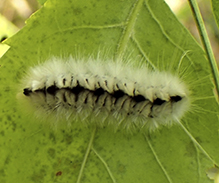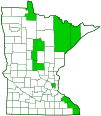hickory tussock moth
(Lophocampa caryae)
Conservation • Description • Habitat • Ecology • Distribution • Taxonomy
|
||||||||
| Hodges # | 8211 |
|||||||
Conservation Status |
||||||||
| IUCN Red List | not listed |
|||||||
| NatureServe | NNR - Unranked |
|||||||
| Minnesota | not listed |
|||||||
Description |
||
Hickory tussock moth is a common, medium-sized, boldly marked, tiger moth. It occurs in the United States from Maine to Maryland, west to Minnesota and Indiana, and south along the Appalachian Mountains to Tennessee. In Canada it occurs from Nova Scotia west to southern Ontario. A disjunct population occurs in southern Mexico. It is uncommon in Minnesota. Caterpillars feed on the leaves of a wide variety of trees, including ash, birch, cherry, elm, hickory, maple, oak, walnut, and willow; shrubs, including blueberry, rose, and sumac; and vines including hops, raspberry, and Virginia creeper. They are found from July through September. Adults are found in deciduous woodlands in May and June. Adults are ¾″ to 1⅛″ (20 to 29 mm) in length and have a 1½″ to 2¼″ (37 to 55 mm) wingspan. The forewings have a pale yellowish-brown or orangish-brown background heavily peppered with flecks of the same color but darker. The veins are dark. The basal, antemedial, median, postmedial, and subterminal lines are each represented by a row of semi-translucent, white or cream-colored spots with dark borders. An oblique dark line extends from the leading edge (costal margin) in the antemedial area to the rear margin near the inner (anal) angle. A dark, cone-shaped patch surrounds a large postmedial spot and tapers to a point at the rear margin. The hindwings are pale translucent yellow with no markings. The thorax is densely hairy. It is the same color as the pale base color of the wings. A pair of thick, brown, oblique stripes join at the rear margin forming a distinctive V shape. The antennae are long and thread-like. On the male each segment has a long, comb-like extension on one side only (pectinate). The caterpillar is white and up to 1¾″ (4.5 cm) long. The first through eighth abdominal segments (A1 through A8) have a small tuft of short, black setae on the front half and a pair of black, narrowly oval spots on the rear half. Segments A1 and A7 each have a pair of very long, movable, black tufts (lashes). The sides of each segment have several black warts bearing tufts of long white setae. |
||
Size |
||
Total length: ¾″ to 1⅛″(20 to 29 mm) Wingspan: 1½″ to 2¼″ (37 to 55 mm) |
||
Similar Species |
||
Habitat |
||
Deciduous woodlands |
||
Ecology |
||
Season |
||
One generation per year: May and June |
||
Behavior |
||
|
||
Life Cycle |
||
The female lays a large batch of 50 or more eggs on the underside of a leaf. Early stage (instar) caterpillar feed together in large clusters. They skeletonize leaves, consuming the tissue but leaving the veins. Pupae overwinter in a cocoon in leaf litter. |
||
Larva Hosts |
||
Leaves of woody plants, including ash, birch, cherry, elm, hickory, maple, oak, walnut, willow, blueberry, rose, sumac, hops, raspberry, and Virginia creeper |
||
Adult Food |
||
|
||
Defense Mechanisms |
||
Caterpillars accumulate toxic chemicals from their host plants, making them poisonous or unpalatable to predators. The hairs are microscopically barbed. They break off easily and embed themselves in predators or in the skin of humans who don’t know that they should avoid touching hairy caterpillars. Both black and white setae contain irritating chemicals. Exposure can cause a rash similar to poison ivy. |
||
Distribution |
||||
|
Sources |
|||
| 4/19/2023 | ||||
Occurrence |
||||
Uncommon in Minnesota |
||||
Taxonomy |
|||
Order |
Lepidoptera (Butterflies and Moths) | ||
Superfamily |
Noctuoidea (Owlet Moths and Allies) | ||
Family |
Erebidae (Underwing, Tiger, Tussock, and Allied Moths) | ||
Subfamily |
Arctiinae (tiger moths and allies) | ||
Tribe |
Arctiini (tiger moths) | ||
| Subtribe | Phaegopterina | ||
Genus |
Lophocampa | ||
In 2011 the family Arctiidae (tiger moths and lichen moths) was transferred to the family Erebidae mostly intact but demoted to a subfamily. The former subfamilies are now tribes, the former tribes now subtribes. |
|||
Synonyms |
|||
|
|||
Common Names |
|||
hickory tussock moth |
|||
Glossary
Anal angle
In insects: The angle at the corner of a wing formed where the outer and inner margins meet.
Costal margin
The leading edge of the forewing of insects.
Instar
The developmental stage of arthropods between each molt; in insects, the developmental stage of the larvae or nymph.
Seta
A stiff, hair-like process on the outer surface of an organism. In Lepidoptera: A usually rigid bristle- or hair-like outgrowth used to sense touch. In mosses: The stalk supporting a spore-bearing capsule and supplying it with nutrients. Plural: setae. Adjective: setose.
Visitor Photos |
|||||
Share your photo of this insect. |
|||||
| This button not working for you? Simply email us at info@MinnesotaSeasons.com. Attach one or more photos and, if you like, a caption. |
|||||
Babette Kis |
|||||
Lophocampa caryae (hickory tussock moth) Best not to touch the hairs on these, they're irritating to the skin. |
 |
||||
MinnesotaSeasons.com Photos |
|||||
|
|||||

Visitor Videos |
|||
Share your video of this insect. |
|||
| This button not working for you? Simply email us at info@MinnesotaSeasons.com. Attach a video, a YouTube link, or a cloud storage link. |
|||
Other Videos |
|||
| POISONOUS white hickory tussock moth caterpillar (lophocampa caryae) Live Free |
|||
About
Aug 17, 2019 |
|||
| Hickory Tussock Moth Larva - Lophocampa Caryae Jean-Paul Sauve |
|||
About
Sep 25, 2014 Tussock Moth larva found in my back yard. |
|||

Visitor Sightings |
|||||
Report a sighting of this insect. |
|||||
| This button not working for you? Simply email us at info@MinnesotaSeasons.com. Be sure to include a location. |
|||||
| Babette Kis 9/21/2020 |
Location: oak hickory woods near Barnes Prairie, Racine Co. WI on shagbark hickory Best not to touch the hairs on these, they're irritating to the skin. |
||||
MinnesotaSeasons.com Sightings |
|||||
|
|||||

Created: 4/19/2023
Last Updated:



